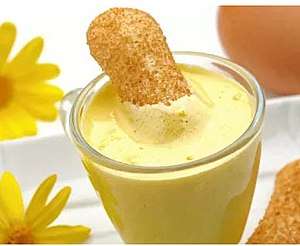Zabaione
Zabaione (Italian pronunciation: [dzabaˈjoːne]) or zabaglione (UK: /ˌzæbəlˈjoʊni/, US: /ˌzɑːb-/, Italian: [dzabaʎˈʎoːne]) is an Italian dessert, or sometimes a beverage, made with egg yolks, sugar, and a sweet wine (usually Moscato d'Asti or Marsala wine).[2] Some versions of the recipe incorporate spirits such as cognac. The dessert version is a light custard, whipped to incorporate a large amount of air. Since the 1960s, in restaurants in areas of the United States with large Italian populations, zabaione is usually served with strawberries, blueberries, peaches, etc. in a champagne coupe.[3] In France, it is called sabayon, while its Italian name is zabaione or zabaglione (or zabajone, an archaic spelling).
 A glass of zabaglione | |
| Alternative names | Zabaglione, zabajone, sabayon |
|---|---|
| Course | Dessert |
| Place of origin | Northern Italy |
| Region or state | Piedmont[1] |
| Main ingredients | Egg yolks, sugar, a sweet wine |
The dessert is popular in Argentina and Uruguay, where it is known as sambayón (from the Piedmontese sambajon) and is a popular ice cream flavour.[4] In Colombia, the name is sabajón. In Venezuela there is also a related egg-based dessert drink called ponche crema. This is consumed almost exclusively at Christmastime.
History
Though accounts vary, the dessert dates far back. In Tuscany, it is said that Zabaglione has been well known since the 16th century, and very popular to the court of Caterina de' Medici. In Piedmont it is said that the original name has been Sambayon, in honor of Saint Pasquale Baylon. In Emilia-Romagna it is said to have been named in 1471 after Giovanni Baglioni name in dialect being: ‘Zuan Bajòun, then shortened in Zabaglione.
Preparation
Classical zabaione uses raw egg yolks cooked in a bain-marie, and most often served with Marsala (though other wines can be substituted).[5] It can be finished with beaten egg white (meringue) or sometimes with whipped cream.
Occasionally, the wine is omitted when the dish is served to children or those who abstain from alcohol. It is then in effect a very different dessert. It may then be sometimes flavoured with a small amount of espresso most commonly called Uovo sbattuto.
In French cuisine
The French adopted the recipe as part of their system of sauces in the 1800s as a dessert cream called sabayon.[2] By the 20th century the name sabayon was also used to describe savory broths and yolk-based sauces.[6]
References
- McGee, Harold (2007). On Food and Cooking: The Science and Lore of the Kitchen (Illustrated ed.). Simon and Schuster. pp. 113–115. ISBN 978-1-4165-5637-4. Retrieved 27 November 2016.
- Foster, John (2 September 2016). "Chef Foster: Hard to Pronounce Treats Offer a Pleasant Surprise with Seasonal Ingredients Added". North Kentucky Tribune. Retrieved 27 November 2016.
- Lebeaux, Rachel (23 September 2016). "Luscious Treats Abound at Dulce D Leche Gelato café". Boston Globe. Retrieved 27 November 2016.
- DeWan, James P. (26 June 2013). "Creamy Indulgence of Zabaglione Whisk, Whisk, Whisk your Way to a Luscious Italian Custard". Chicago Tribune. Retrieved 27 November 2016.
- "Definition of SABAYON". www.merriam-webster.com.